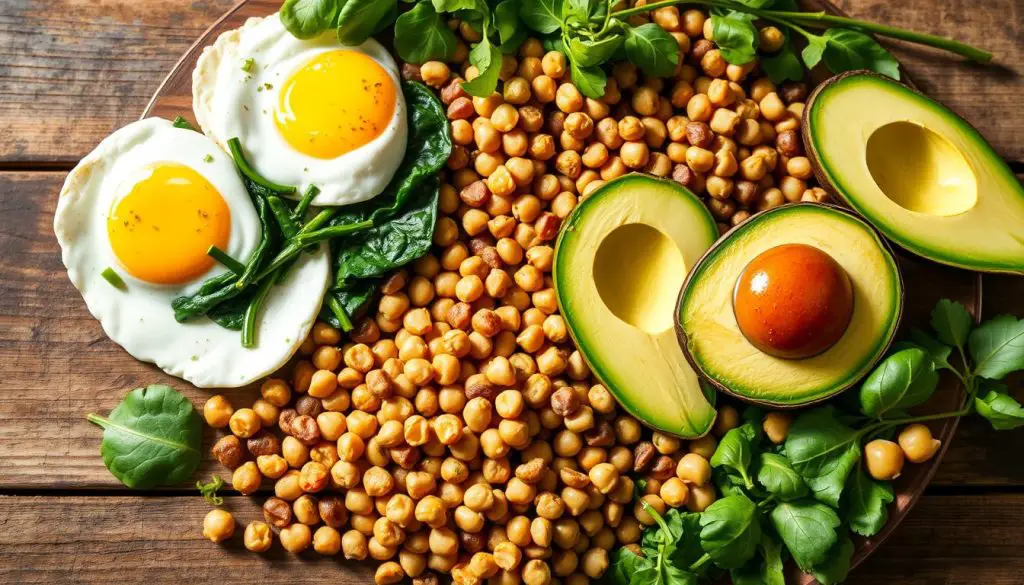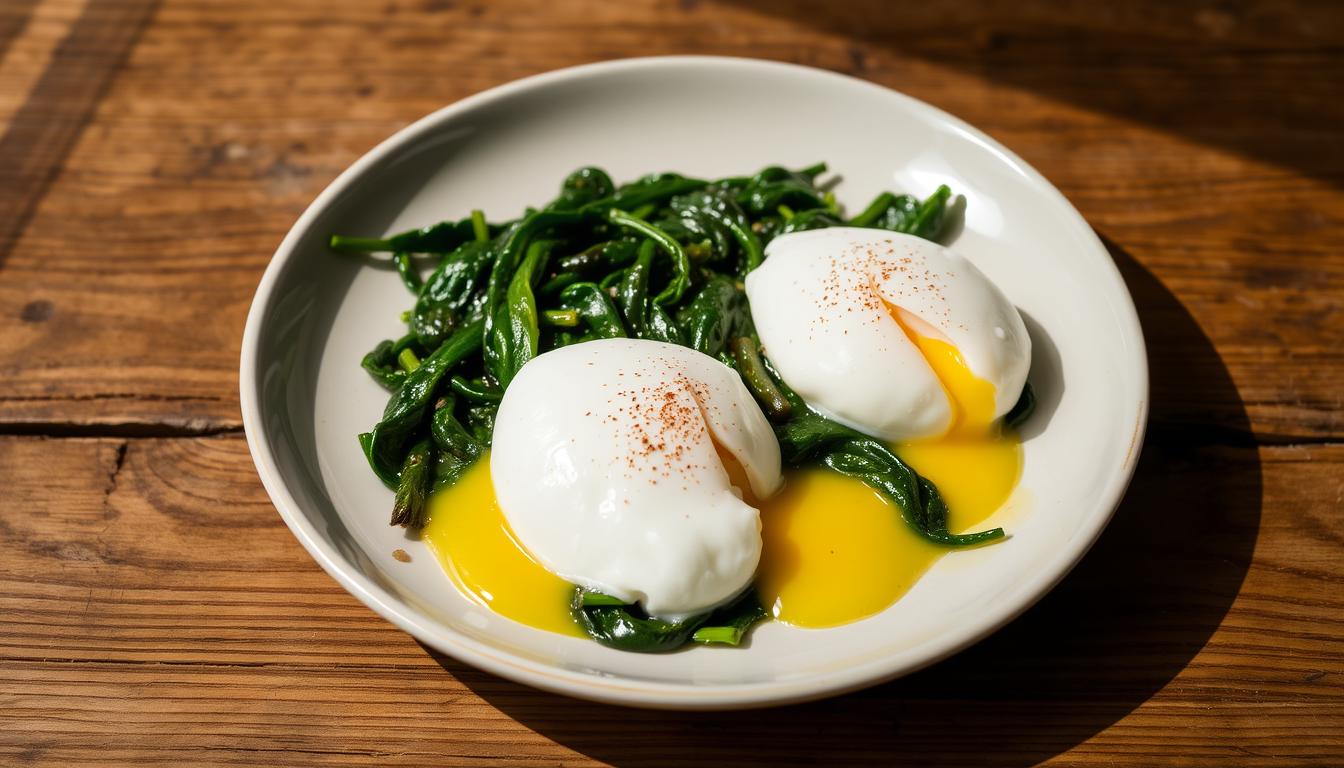Did you know a simple breakfast of poached eggs and sautéed spinach could help manage fibromyalgia symptoms? Over 4 million adults in the U.S. live with this chronic condition. A nutrient-rich diet can greatly improve your life quality.
Some foods can make fibromyalgia symptoms worse. But, adding anti-inflammatory ingredients like these to your meals can help. This way, you can use nutrition to ease your symptoms and take back control of your health.
A study showed a 53% drop in pediatrician visits in just a year and a half with healthier habits. Think of the impact a simple breakfast like this could have on your fibromyalgia journey.
What is Fibromyalgia?
Fibromyalgia is a chronic condition that causes widespread pain, fatigue, sleep issues, and depression. The exact cause is not known, but it’s thought to involve how the brain and nervous system handle pain. People with fibromyalgia often feel pain more intensely, making simple tasks hard.
Symptoms and Causes of Fibromyalgia
The main symptoms of fibromyalgia are chronic pain, fatigue, sleep disorders, and depression. These symptoms greatly affect a person’s life and daily activities. The exact causes are not known, but it’s believed to involve genetics, environment, and the nervous system.
- Chronic pain and muscle aches throughout the body
- Extreme fatigue and lack of energy
- Difficulty sleeping or non-restorative sleep
- Cognitive impairments, such as memory and concentration problems
- Mood disorders, including depression and anxiety
Fibromyalgia affects about 3.7 million Americans. Middle-aged women are most often affected, but men, younger women, and children can also get it.
| Symptom | Description |
|---|---|
| Chronic Pain | Widespread musculoskeletal pain and stiffness throughout the body |
| Fatigue | Extreme tiredness and lack of energy, even after rest |
| Sleep Disorders | Difficulty falling asleep, staying asleep, or non-restorative sleep |
| Depression | Mood disorders, including persistent feelings of sadness and anxiety |
How Diet Can Help Manage Fibromyalgia
There’s no cure for fibromyalgia, but diet can help manage its symptoms. Low-calorie diets, vegetarian diets, and low-FODMAP diets are good options. They help reduce inflammation and provide essential nutrients.
By choosing the right foods, people with fibromyalgia can feel better. They might experience less pain, better sleep, and overall well-being.
An anti-inflammatory diet is great for fibromyalgia. It focuses on foods with anti-inflammatory compounds like omega-3s and antioxidants. Eating more whole, plant-based foods can also help.
For some, a low-FODMAP diet is beneficial. It limits carbs that can cause digestive problems and inflammation. Avoiding these foods can help reduce symptoms.
Managing fibromyalgia through diet means finding what works for you. Working with a registered dietitian or healthcare professional is key. They can help create a dietary plan tailored to your needs.
Poached Eggs with Sautéed Spinach for Fibromyalgia
People with fibromyalgia can find relief in a tasty breakfast of poached eggs and sautéed spinach. This meal is not just good for health but also helps manage fibromyalgia symptoms.
Why This Recipe is Beneficial for Fibromyalgia
Poached eggs are great for those with fibromyalgia. They are a nutrient-dense source of protein, packed with vitamins and minerals. Spinach, on the other hand, is full of anti-inflammatory compounds like vitamins A, C, and E, and magnesium. These can help ease fibromyalgia symptoms.
This breakfast combines two powerful ingredients. It’s a tasty way to nourish your body and manage pain. The anti-inflammatory benefits of poached eggs and spinach can reduce inflammation and offer a nutrient-rich breakfast for fibromyalgia sufferers.
Eggs’ high-quality protein supports muscle function. The nutrient-rich spinach adds essential vitamins and minerals for managing fibromyalgia symptoms. This pain management through nutrition approach is a valuable part of treating fibromyalgia.
Anti-Inflammatory Benefits of Spinach
If you have fibromyalgia, adding spinach to your diet can help a lot. This green is full of nutrients that fight inflammation. It can lessen the pain that comes with fibromyalgia.
Spinach is rich in vitamins A, C, and E, and magnesium. These work together to fight inflammation in the body. It also has lots of antioxidants. These help protect the body from harmful free radicals.
- Vitamin A in spinach helps regulate the immune system and reduce inflammation.
- Vitamin C is a potent antioxidant that can help lower levels of inflammatory markers.
- Vitamin E is a fat-soluble nutrient that protects cells from oxidative stress and inflammation.
- Magnesium in spinach plays a key role in muscle and nerve function, which can be disrupted in fibromyalgia.
Adding spinach to your meals can help manage fibromyalgia symptoms. You can sauté it, add it to salads, or blend it into smoothies. It’s a great choice for a fibromyalgia-friendly diet.

The vitamins and minerals in spinach work together to reduce inflammation with spinach. It’s a top pick for those looking for natural ways to manage fibromyalgia. Using spinach can help you live a healthier, more comfortable life.
Nutrient-Rich Eggs for Fibromyalgia
Eggs are a great choice for managing fibromyalgia symptoms. They are packed with high-quality protein and important vitamins and minerals. These nutrients can really help those with this chronic condition.
Egg Nutrients that Support Fibromyalgia Management
Eggs are full of B vitamins, like vitamin B12. These are key for energy and nerve health. They also have choline, which is good for the brain and thinking skills. Plus, the protein in eggs helps with muscle health and recovery.
Adding eggs to your diet can help manage fibromyalgia symptoms. It can also boost your overall health.
Eggs are easy to add to many meals and snacks. They’re great for people with fibromyalgia. You can make poached eggs or frittatas and enjoy their health benefits.
Preparing the Perfect Poached Egg
Poaching eggs is a simple way to enjoy their nutritional benefits. Start by heating a skillet of water with a splash of vinegar to a gentle simmer. Crack each egg into a small cup or ramekin, then gently slip the eggs into the simmering water.
Cook the eggs for 4-5 minutes, until the whites are set and the yolks are runny. Remove the eggs from the water using a slotted spoon. Serve immediately for a delicious and nutrient-rich breakfast.
Here’s a step-by-step guide to how to poach eggs and master the technique for poaching eggs to achieve the perfect poached egg:
- Fill a skillet or saucepan with 2-3 inches of water and add a splash of white vinegar. Bring the water to a gentle simmer over medium heat.
- Crack each egg into a small cup or ramekin, being careful not to break the yolk.
- Gently slip the eggs from the cup into the simmering water. The vinegar will help the whites hold their shape.
- Cook the eggs for 4-5 minutes, or until the whites are completely set, but the yolks are runny.
- Use a slotted spoon to carefully remove the poached eggs from the water, allowing any excess water to drain off.
- Serve the poached eggs immediately, either on their own or as part of a delicious breakfast.

With a little practice, you’ll be able to achieve the perfect poached egg every time. This will give you a nutritious and satisfying start to your day.
Sautéing Spinach for Maximum Flavor
To make the spinach in this recipe taste better, use the right sautéing methods. Start by heating a skillet over medium-high heat. Add a bit of olive oil or a small piece of butter.
When the oil starts shimmering or the butter melts, add the spinach leaves. Sauté the spinach, stirring often, until it’s soft and tender. This should take about 2-3 minutes.
This quick cooking method keeps the spinach’s nutrients and makes it taste great. Add a pinch of salt and some black pepper to bring out the flavor.
The secret to great sautéed spinach is in the technique. Don’t overcrowd the pan, as it can steam instead of sauté. If needed, cook in batches to let the spinach brown and caramelize well.
Don’t stir too much, as it stops the spinach from getting that nice seared taste. By mastering sautéing spinach, you get a side dish that’s full of nutrients and tastes amazing. It goes well with the poached eggs in this recipe, making a meal that’s both satisfying and healthy.
How you prepare your ingredients matters a lot for their nutrients. Sautéing is a top choice for keeping spinach’s vitamins, minerals, and antioxidants. It’s perfect for those with fibromyalgia.
Folate-Rich Foods for Fibromyalgia
Folate, also known as vitamin B9, is key for managing fibromyalgia. People with fibromyalgia often have less folate. This can lead to fatigue, depression, and brain fog. Eating folate-rich foods like spinach can help improve your health and reduce fibromyalgia symptoms.
Spinach in this recipe is packed with folate. It’s vital for making red blood cells and for the nervous system. Adding spinach to your meals can help manage fibromyalgia and boost your overall health.
Folate-Rich Foods to Incorporate into Your Fibromyalgia Diet
- Spinach
- Lentils
- Asparagus
- Avocado
- Broccoli
- Brussels sprouts
- Peas
- Organ meats (such as liver)
- Nuts and seeds
| Food | Folate Content |
|---|---|
| Spinach (1 cup, cooked) | 263 mcg (66% DV) |
| Lentils (1 cup, cooked) | 358 mcg (90% DV) |
| Avocado (1 medium) | 122 mcg (31% DV) |
| Broccoli (1 cup, cooked) | 168 mcg (42% DV) |
| Beef liver (3 oz, cooked) | 215 mcg (54% DV) |
Eating these folate-rich foods boosts your nutrient intake. This is important for managing fibromyalgia symptoms and supporting your health.

Magnesium in Spinach for Fibromyalgia Relief
Spinach is not just good for you because it’s anti-inflammatory. It’s also packed with magnesium, a mineral that helps those with fibromyalgia feel better. Magnesium is key for muscle health and pain control. People with fibromyalgia often have less of it.
Eating magnesium-rich spinach can help. For example, try it in a poached egg and sautéed spinach dish. You might feel less muscle pain and overall better. The magnesium benefits for fibromyalgia include:
- Improved muscle function and reduced muscle cramps
- Reduced inflammation and joint pain
- Enhanced sleep quality and reduced fatigue
- Better management of stress and anxiety
Spinach is a top choice for managing fibromyalgia with magnesium-rich foods. One cup of cooked spinach gives you almost 40% of your daily magnesium. Add it to poached eggs for a meal that supports your fibromyalgia management.
If you want to naturally boost your magnesium and ease fibromyalgia symptoms, add more spinach as a source of magnesium to your diet. This green is not only tasty but also helps with fibromyalgia-friendly meals.
Fiber for Fibromyalgia and Gut Health
Fiber is key for people with fibromyalgia. It helps with digestion and can ease stomach problems. The sautéed spinach in this recipe is full of fiber, both kinds. Adding high-fiber foods to your diet can help with bowel movements, reduce inflammation, and boost gut health. This can help manage fibromyalgia symptoms better.
High-Fiber Foods for Fibromyalgia Diet
To get enough fiber for your fibromyalgia and gut health, try these high-fiber foods:
- Whole grains (such as oats, quinoa, and brown rice)
- Legumes (including beans, lentils, and chickpeas)
- Berries (like blueberries, raspberries, and blackberries)
- Nuts and seeds (such as chia, flax, and almonds)
- Brightly colored fruits and vegetables (including spinach, broccoli, and apples)
Adding these high-fiber foods to your meals can help you meet your fiber needs. It supports your health and well-being while managing fibromyalgia.
Omega-3 Eggs for Reducing Inflammation
Eggs are not just good for you; they’re also a great source of omega-3 fatty acids. These acids are known for fighting inflammation. People with fibromyalgia often have more inflammation. Eating omega-3 eggs can help lower this inflammation and ease pain.
Omega-3 fatty acids in eggs have anti-inflammatory properties. They can help those with fibromyalgia. Adding these healthy fats to your diet may reduce body inflammation. This could lessen fibromyalgia symptoms.
The omega-3 benefits for fibromyalgia go beyond fighting inflammation. They also support brain health and thinking skills. Adding omega-3 eggs to your diet can help manage fibromyalgia in many ways.
The anti-inflammatory properties of omega-3 eggs make them great for fibromyalgia. Eating these eggs can help your body fight inflammation. This can ease some of the tough symptoms of fibromyalgia. Try adding omega-3 eggs to your diet to help manage fibromyalgia.
Vitamin E in Spinach for Antioxidant Support
Adding vitamin E-rich spinach to your meals can offer strong antioxidant benefits. These benefits may help with fibromyalgia symptoms. Spinach is packed with anti-inflammatory nutrients and vitamin E. This vitamin is key in fighting off harmful free radicals that cause chronic inflammation in fibromyalgia.
Vitamin E is a fat-soluble vitamin that fights off oxidative stress and damage. Eating spinach, which is full of vitamin E, can boost your body’s defenses. This might lead to less inflammation and better overall health.

The antioxidant support from spinach’s vitamin E makes it a great addition to the poached eggs and sautéed spinach recipe. This recipe is tailored for those with fibromyalgia. It helps nourish your body and can help manage your condition’s symptoms.
Serving Suggestions for Poached Eggs and Sautéed Spinach
This poached eggs and sautéed spinach recipe is great in many ways. It’s perfect for anyone looking for a tasty, fibromyalgia-friendly breakfast. You can make it your own, whether you want a big meal or something light.
For a bigger meal, place the eggs and spinach on whole grain toast. The toast’s nutty taste goes well with the eggs and spinach. Adding grilled chicken or feta cheese makes it even more filling.
If you’re watching carbs, skip the toast. The eggs and spinach alone are full of nutrients. They make a great, low-carb breakfast.
Want something new? Try the eggs and spinach with roasted sweet potatoes. The sweet potatoes add natural sweetness and extra nutrients. They’re a great match for the savory flavors of the dish.
How you serve this recipe is up to you. The goal is to enjoy the ways to enjoy poached eggs and sautéed spinach, pairing ideas for fibromyalgia-friendly breakfast, and customizing the recipe for individual preferences. It’s a tasty, flexible option for managing fibromyalgia symptoms.
Healthy Protein Sources for Fibromyalgia Diet
For those with fibromyalgia, getting enough high-quality protein is key. Protein helps keep muscles strong and aids in recovery. This is vital for managing fibromyalgia symptoms. Eggs, as seen in the poached egg and sautéed spinach recipe, are a great start. But there are many other protein-rich foods that can be part of a fibromyalgia-friendly diet.
Some lean protein options that may help alleviate fibromyalgia symptoms include:
- Lean meats such as chicken, turkey, and pork
- Fish, like salmon, which is full of omega-3 fatty acids
- Legumes like beans, lentils, and chickpeas, which offer plant-based protein and fiber
- Dairy products such as Greek yogurt, cottage cheese, and low-fat milk, which provide high-quality protein and other nutrients
Adding a variety of these protein-rich foods to meals and snacks can help meet protein needs. This may help manage symptoms and improve overall health for those with fibromyalgia.
Pain Management Through Nutrition for Fibromyalgia
There’s no cure for fibromyalgia, but diet can help manage pain. Eating foods like poached eggs and sautéed spinach can reduce pain. These foods are full of nutrients and anti-inflammatory compounds.
Adding more meals with these ingredients can help your body heal. This is important for people with fibromyalgia. About 4 million adults in the U.S. live with this condition.
There are many diets that can help with fibromyalgia symptoms. Eating foods rich in omega-3s, magnesium, and folate is key. These nutrients help fight inflammation and support your body’s functions.
Source Links
- https://thenaturalnutritionist.com.au/a-week-on-my-plate/
- https://www.kitchenstewardship.com/paleo-hash-recipe/
- https://www.mediterraneanliving.com/21-authentic-mediterranean-food-recipes/
- https://www.healthline.com/nutrition/eggs-and-rheumatoid-arthritis
- https://www.realsimple.com/food-recipes/recipe-collections-favorites/best-anti-inflammatory-recipes
- https://www.eatingwell.com/article/291150/fibromyalgia-diet-foods-you-should-eat-and-foods-you-should-avoid/
- https://www.healthline.com/nutrition/whole-30
- https://www.healthrising.org/blog/2019/08/08/a-message-of-strength-and-hope-from-whitney-dafoe-on-severe-me-day/
- https://www.fibrofix.com/pages/21-day-detox
- https://www.drtereo.com/blog/recipes-for-health-
- https://jbsnourishwell.com/tag/anti-inflammatory-foods/
- https://www.verywellhealth.com/eating-for-fatty-liver-disease-4691109
- https://www.healthline.com/nutrition/fibromyalgia-diet-recipes
- https://painresource.com/fibromyalgia/fibromyalgia-recipes-reduce-inflammation/
- https://www.healthline.com/health/12-high-protein-breakfasts
- https://www.healthline.com/nutrition/cooking-nutrient-content
- https://www.healthline.com/nutrition/foods-with-choline
- https://www.healthgrades.com/right-care/food-nutrition-and-diet/egg-whites
- https://www.joannetrujilloacupuncture.com/general-8-1
- https://www.d-signednutrition.com/wp-content/uploads/2017/06/Mini-Nutrients-for-Maximum-Health-Dee-Harris-4.20.17.pdf
- https://www.healthline.com/nutrition/primal-diet
- https://www.ibsclinics.co.uk/what-to-eat-for-breakfast-with-ibs-flare-up/
- https://anandayogadetox.com/detox-addons/anti-candida-program/
- https://dokumen.pub/the-anti-inflammation-cookbook-the-delicious-way-to-reduce-inflammation-and-stay-healthy-1st-edition-1452139881-9781452139883-1452147191-9781452147192.html
- https://www.avogel.co.uk/health/skin/ageing-skin/3-top-foods-for-wrinkles/
- https://www.healthline.com/nutrition/easy-ways-to-use-eggs
- https://www.mobeforlife.com/resources
- https://nourishingmeals.com/diet/low-fodmap
- https://simplysusan.com.au/typical-meals-in-my-home/
- https://www.healthdirect.gov.au/how-to-meet-your-iron-needs-infographic
